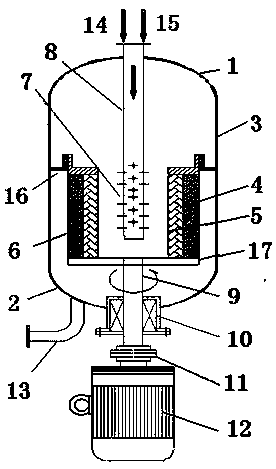Novel organic waste water treatment process
A technology for organic wastewater treatment and treatment process, applied in the field of environmental protection, can solve the problems of metal loss and high COD removal capacity, and achieve the effects of reducing emissions, high COD removal effect, and shortening reaction time.
- Summary
- Abstract
- Description
- Claims
- Application Information
AI Technical Summary
Problems solved by technology
Method used
Image
Examples
preparation example Construction
[0028] Preparation of Catalyst A1 (Fe / AC)
[0029] The diameter is 2.0mm, the specific surface area is 704m 2 / g, pore volume 0.7cm 3 / g, commercial columnar activated carbon strips with an average pore size of 2.0 nm were dried at 120 °C for later use. Weigh 500g of dried activated carbon strips, and use Fe(NO 3 ) 3 9H 2 O by Fe 2 o 3 Accounting for the proportion of 8% of the total weight of the catalyst is made into a solution. The activated carbon strip was impregnated with an equal volume of the solution for 4 hours, dried at 80°C, calcined at 550°C under a nitrogen atmosphere for 4 hours, and taken out after the temperature dropped to room temperature to obtain catalyst A1.
[0030] Preparation of Catalyst A2 (Mn / AC)
[0031] The diameter is 2.0mm, the specific surface area is 704m 2 / g, pore volume 0.7cm 3 / g, commercial columnar activated carbon strips with an average pore size of 2.0 nm were dried at 120 °C for later use. Weigh 500g of dried activated carbo...
Embodiment 1
[0041] The catalysts A1 and B1 were loaded into the inner rotating bed and the outer rotating bed of the reactor respectively according to volume percentages of 65% and 35%, and the distance between the inner and outer rotating beds was 5 mm. The total volume of the catalyst is 100cm 3 . Reaction conditions: the COD of acid scarlet simulated dye wastewater is 286.3 mg / L, the feed rate is 200 mL / h, and the ozone concentration is 8.0 g / m 3 , the gas flow rate was 400 mL / min, the rotary bed speed was 600 rpm, and the reaction was carried out at normal temperature and pressure. After the reaction, the COD of the liquid is tested, and the catalyst activity is measured according to the removal rate of COD. After the reaction, the content of copper ions in the liquid was tested by inductively coupled plasma mass spectrometry (ICP-MS) to investigate the loss of metals. The results are listed in Table 1.
Embodiment 2
[0043] Catalysts A2 and B1 were loaded into the reactor according to volume percentages of 20% and 80% respectively, the rotational speed of the rotating bed was 200 rpm, there was no gap between the inner and outer rotating beds, and other reaction conditions were the same as in Example 1. The results are listed in Table 1.
PUM
| Property | Measurement | Unit |
|---|---|---|
| diameter | aaaaa | aaaaa |
| specific surface area | aaaaa | aaaaa |
| pore size | aaaaa | aaaaa |
Abstract
Description
Claims
Application Information
 Login to View More
Login to View More - R&D
- Intellectual Property
- Life Sciences
- Materials
- Tech Scout
- Unparalleled Data Quality
- Higher Quality Content
- 60% Fewer Hallucinations
Browse by: Latest US Patents, China's latest patents, Technical Efficacy Thesaurus, Application Domain, Technology Topic, Popular Technical Reports.
© 2025 PatSnap. All rights reserved.Legal|Privacy policy|Modern Slavery Act Transparency Statement|Sitemap|About US| Contact US: help@patsnap.com



